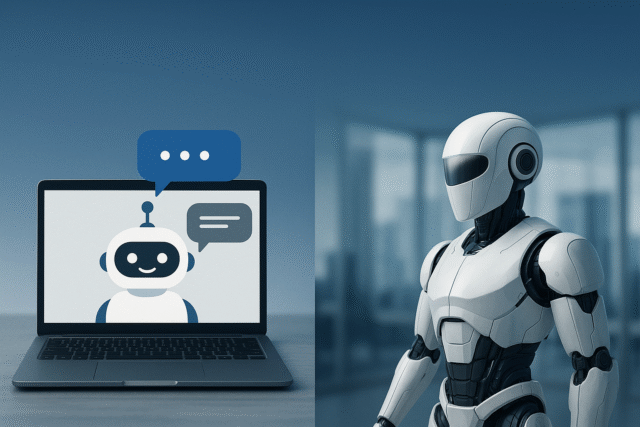The next wave of AI assistants: From chatbots to autonomous agents

AI assistants, like chatbots, have been providing customer support and functioning in sales and internal support roles for a very long time. Autonomous agents are the next level of AI, as they incorporate reasoning, planning, and execution.
This is already happening on a larger scale in enterprises, with autonomous AI agents streamlining development processes. 79 percent of executives in PwC's report, AI and the Future of Work, maintain that agentic AI is a key driver for prioritizing automation and productivity.
Organizations’ priorities shift from fixed-response systems to proactive autonomous AI chatbots. The underlying architecture, governance frameworks, and data foundations are critical for adoption.
From Chatbots to Agents
Chatbots rely on intent recognition and pattern recognition. On the other hand, AI agents work with goals and incorporate decision-making. Agents can evaluate work, design, and implement multi-step actions, and communicate with other systems and end APIs. The fusion of AI development services and AI agent development with other practices and the engineering of domain data infrastructures has become prevalent.
These functionalities provide sufficient data-engineered systems to design, implement, and control agents. Enterprises focus on the development of AI software on constructing the reasoning and orchestration frameworks while routing engineering teams to curate the controlled and trustworthy data pipelines to provide agents.
Both balanced mechanisms are needed to ensure agentic AI development responds predictably to organizational needs and complies with the directives of the business.
Core Architectural Components of AI Assistants
An AI Agent system comprises a reasoning engine, a memory module, an orchestration tier, and tool access components. The reasoning engine decomposes goals and plans the decisions. The memory module holds the state and contextual information to provide consistency over a long period. The orchestration layer of the agents coordinates control over multiple subsystems, while the tool modules link to APIs, databases, or enterprise software.
Systems of AI software development solutions also highlight modularity and scalability. This means that teams can modify reasoning models, integrate new data sources, and expand functionality without having to redesign the entire system. Effective orchestration frameworks also provide logging and monitoring tools to ensure transparency and accountability, which are necessary for compliance and reliability.
AI agents have already made their way into various enterprise domains. In finance, they are used to reconcile accounts and manage reports. In healthcare, they process patient intake data and summarize clinical documentation. 63 percent of organizations deploying AI agents report measurable improvements in operational efficiency in the first 6 months, according to data from Deloitte.
In marketing, AI automates analytics tasks and schedules content, while in logistics, it manages the coordination of supplies and streamlines routes. A report by Business Insider on Omega Healthcare describes an implementation that cut down documentation time by 40 percent and processed documents with 99.5 percent accuracy. This illustrates AI's ability to enhance throughput while drastically minimizing errors within fixed workflows. The best performance is said to come from narrowly defined domains where dimensions of the data and results are inextricably linked.
Data Engineering and Infrastructure
AI agents need access to and the continuous management of data. This means they need pipelines to collect, clean, and direct data from different systems. Data Engineering guarantees the precision of this process while also making it auditable.
In terms of data engineering services & solutions, providers offer comprehensive capabilities for ingestion, transformation, quality control, and observability.
A 2025 IDC report states that organizations with refined data engineering pipelines experience model deployment cycles that are 2.5 times faster than those that use ad hoc data flows. Data governance frameworks need to specify how agents access and store data while oversight frameworks monitor model performance, drift, and compliance. Data engineering must be consistent; otherwise, agents will work with obsolete data, leading to operational and compliance risks.
Challenges, Risks, and Mitigations
Autonomous agents can expose new operational and security risks. They can create inaccurate outputs, misunderstand goals, and take unintended actions. Gartner predicted that, by the end of 2025, as many as 30 percent of early agentic AI projects will fail within the first 5 years of implementation because of poor oversight and data governance. Agents operate with minimal supervision, so security teams see them as potential weak spots for unintended data leakage and rogue action execution.
SailPoint 2022 surveys also discovered that 96 percent of IT executives surveyed regard autonomous agents as a security risk. To reduce security risk, enterprises implement 3 layers of operational controls comprising action validation, sandboxed execution environments, and audit logging.
Continuous monitoring of the control layers, as well as human oversight, is necessary for accountability on the operational layers and to mitigate the risk of unintended consequences.
Using agency AI should be done slowly and deliberately. Most enterprises start with pilot programs focused on small, definable, and measurable tasks. Success with this approach hinges on knowing what success is, having aligned metrics, and coordinated human attention. Having a modular design means that encountering updated reasoning models or orchestration logic won’t require a shutdown or major disruption of a production system.
Routine system audits will verify the presence of bias, drift, or policy misalignment. According to data from McKinsey, organizations with structured pilot-to-scale approaches get as much as 60 percent higher success rates as opposed to the direct deployment of agents into complex surroundings. A closed positive feedback loop will ensure that agents perform tasks and produce outcomes that are dependable and auditable.
What do you think about the shift from simple chatbots to fully autonomous AI agents? Let us know in the comments.
